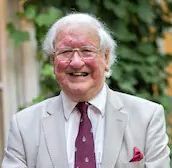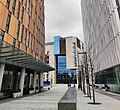
Imperial College London is a public research university in London, England. Its history began with Prince Albert, consort of Queen Victoria, who developed his vision for a cultural area that included the Royal Albert Hall, Victoria & Albert Museum, Natural History Museum and several royal colleges. In 1907, Imperial College London was established by royal charter, unifying the Royal College of Science, Royal School of Mines, and City and Guilds of London Institute. In 1988, the Imperial College School of Medicine was formed by merging with St Mary's Hospital Medical School. In 2004, Queen Elizabeth II opened the Imperial College Business School.

King's College London is a public research university located in London, England. King's was established by royal charter in 1829 under the patronage of King George IV and the Duke of Wellington. In 1836, King's became one of the two founding colleges of the University of London. It is one of the oldest university-level institutions in England. In the late 20th century, King's grew through a series of mergers, including with Queen Elizabeth College and Chelsea College of Science and Technology, the Institute of Psychiatry, the United Medical and Dental Schools of Guy's and St Thomas' Hospitals and the Florence Nightingale School of Nursing and Midwifery.

The Hong Kong Polytechnic University (PolyU) is a public research university located in Hung Hom, Hong Kong. The university is one of the eight government-funded degree-granting tertiary institutions in Hong Kong. Founded in 1937 as the first Government Trade School, it is the first institution to provide technical education in Hong Kong. In 1994, the Legislative Council of Hong Kong passed a bill which granted the former Hong Kong Polytechnic official university status.

The Royal Festival Hall is a 2,700-seat concert, dance and talks venue within Southbank Centre in London, England. It is situated on the South Bank of the River Thames, not far from Hungerford Bridge, in the London Borough of Lambeth. It is a Grade I listed building, the first post-war building to become so protected. The London Philharmonic Orchestra, the Philharmonia Orchestra, the Orchestra of the Age of Enlightenment, the London Sinfonietta, Chineke! and Aurora are resident orchestras at Southbank Centre.

Addenbrooke's Hospital is a large teaching hospital and research centre in Cambridge, England, with strong affiliations to the University of Cambridge. Addenbrooke's Hospital is located on the Cambridge Biomedical Campus. It is run by Cambridge University Hospitals NHS Foundation Trust and is a designated academic health science centre. It is also the East of England's major trauma centre and was the first such centre to be operational in the United Kingdom.

Paddington Waterside is a developed area around Paddington Station in London.

Kennesaw State University (KSU) is a public research university in the state of Georgia with two campuses in the Atlanta metropolitan area, one in Kennesaw and the other in Marietta on a combined 581 acres (235 ha) of land. The school was founded in 1963 by the Georgia Board of Regents using local bonds and a federal space-grant during a time of major Georgia economic expansion after World War II. KSU also holds classes at the Cobb Galleria Centre, Dalton State College, and in Paulding County (Dallas). The total enrollment exceeds 43,000 students making KSU the second-largest university by enrollment in Georgia while also having the largest freshman class in the state as well.

The Eastman Dental Hospital was based on Gray's Inn Road until it co-located with the University College London ear, nose, throat, balance and hearing services on Huntley Street, London, as the Royal National ENT and Eastman Dental Hospitals in October 2019. The hospital continues to provide specialist dental treatment as well as ear, nose, throat, hearing, speech and balance services and is part of the University College London Hospitals NHS Foundation Trust.
The College of Nanoscale Science and Engineering is the college of nanotechnology at the SUNY Polytechnic Institute campus in Albany, New York. Founded in 2004 at the University at Albany, SUNY, the college underwent rapid expansion in the late-2000s and early-2010s before merging with the SUNY Institute of Technology in 2014. The college will rejoin the University at Albany in 2023. The college was the first college in the United States devoted to nanotechnology.

The Francis Crick Institute is a biomedical research centre in London, which was established in 2010 and opened in 2016. The institute is a partnership between Cancer Research UK, Imperial College London, King's College London (KCL), the Medical Research Council, University College London (UCL) and the Wellcome Trust. The institute has 1,500 staff, including 1,250 scientists, and an annual budget of over £100 million, making it the biggest single biomedical laboratory in Europe.

The Homewood Campus is the main academic and administrative center of the Johns Hopkins University. It is located at 3400 North Charles Street in Baltimore, Maryland. It houses the two major undergraduate schools: the Zanvyl Krieger School of Arts and Sciences and the Whiting School of Engineering.

Here East is a media complex located in the Olympic Park in East London, built specially for the 2012 London Olympics. It is located at the site of the former Hackney Wick Stadium close to the Riverbank Arena in Hackney Wick.

The Agricultural and Technical College of North Carolina Historic District is 10.1-acre (41,000 m2) historic district along the western boundary of the campus of North Carolina Agricultural and Technical State University in Greensboro, North Carolina. The area includes five historical Colonial Revival, Classical Revival style buildings. Some significant structures are among those located within the Historic District include the James B. Dudley Memorial Building and Harrison Auditorium. The district has been listed on the National Register of Historic Places since October 20, 1988.

The Department of Chemistry is responsible for chemistry teaching and research at Imperial College London. The department is one of the largest in the UK with around 63 academic staff, 10 teaching fellows, 95 postdoctoral research scientists and research fellows and 1150 students, including 240 PhD students,150 MRes students and around 750 students studying undergraduate courses. This community is further supported by over 45 support and administrative staff. The department is based across two sites.

The College of Engineering is a college within the University of Notre Dame. The Dean of the College of Engineering is Patricia J. Culligan, Ph.D. Its graduate school for Engineering is ranked #47 in the USA and #15 for undergraduate.

Sir John Michael Leal Uren was a British businessman. He served as the chairman of Civil & Marine from 1955 to 2006. He donated GBP £40 million to his alma mater, Imperial College London, becoming the most generous benefactor in the College’s history.

The Henry Royce Institute is the UK’s national institute for advanced materials research and innovation. Its vision is to identify challenges and to stimulate innovation in advanced materials research to support sustainable growth and development. Royce aims to be a "single front door" to the UK’s materials research community. Its stated mission is to “support world-recognised excellence in UK materials research, accelerating commercial exploitation of innovations, and delivering positive economic and societal impact for the UK.”

Science House is a heritage-listed commercial building located at 157–169 Gloucester Street and Essex Street, in the inner city Sydney suburb of The Rocks in the City of Sydney local government area of New South Wales, Australia. It was designed by Peddle Thorp & Walker Architects and built in 1930 by John Grant and Sons, Master Builders. It was also known as Sports House from 1978–1991. The building is owned by Denwol, a property group owned and controlled by Phillip Wolanski AM. It was added to the New South Wales State Heritage Register on 10 May 2002.

Reuben College is a new constituent college of the University of Oxford in England. The plans for the new graduate college, preliminarily named Parks College, were announced in December 2018. It is the first new Oxford or Cambridge college founded since 1990, when the postgraduate Kellogg College, Oxford, was established. It will be located in the Science Area on the historic Radcliffe Science Library site and took in its first graduate students in the 2021–2022 academic year.
Justin Peter Cobb is a British professor of orthopaedic surgery at Imperial College London, known for introducing medical robotics into orthopaedic surgery. He is a member of the Royal Medical Household and was royal orthopaedic surgeon to the Queen. He is on the staff at King Edward VII's Hospital (KEVII) and is civilian advisor in orthopaedics to the Royal Air Force (RAF). His research has also included themes relating to designing new devices such as for ceramic hip resurfacing, 3D printing in orthopaedics, and training in surgical skills. He is a director of the MSk laboratory based in the Sir Michael Uren Hub.
























